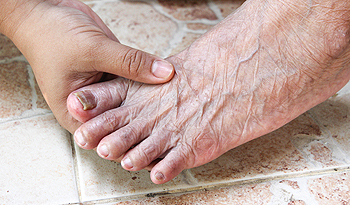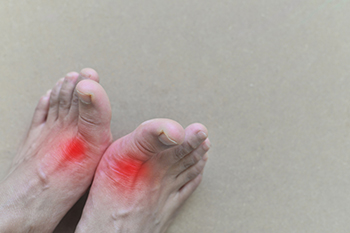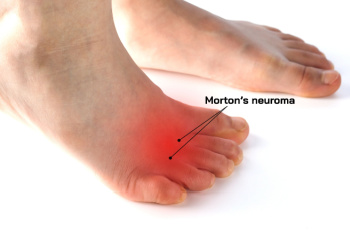Items filtered by date: January 2025
Who Is Susceptible to Toenail Fungus?

Toenail fungus, or onychomycosis, is a common infection where fungi infiltrate the nail bed, leading to discoloration, thickening, and brittleness. Visually, affected nails may appear yellow, brown, or white, and can become distorted or crumbly. This condition arises when fungi enter through cracks in the nail or surrounding skin, thriving in warm, moist environments. Risk factors include advanced age, diabetes, poor circulation, and a history of athlete's foot. Treatment options encompass oral antifungal medications, topical treatments, and in some cases, surgical removal of the affected nail. Early intervention is critical to prevent the infection from spreading or causing further complications. If you suspect you have toenail fungus, it is suggested that you consult a podiatrist for an accurate diagnosis and personalized treatment plan.
For more information about treatment, contact Wendy K. Stinson, DPM of New Jersey. Our doctor can provide the care you need to keep you pain-free and on your feet.
Toenail Fungus Treatment
Toenail fungus is a condition that affects many people and can be especially hard to get rid of. Fortunately, there are several methods to go about treating and avoiding it.
Antifungals & Deterrence
Oral antifungal medicine has been shown to be effective in many cases. It is important to consult with a podiatrist to determine the proper regiment for you, or potentially explore other options.
Applying foot powder on the feet and shoes helps keep the feet free of moisture and sweat.
Sandals or open toed shoes – Wearing these will allow air movement and help keep feet dry. They also expose your feet to light, which fungus cannot tolerate. Socks with moisture wicking material also help as well.
If you have any questions please contact our office located in Parsippany-Troy Hills, NJ . We offer the newest diagnostic and treatment technologies for all your foot and ankle needs.
Foot Pain and Pitfalls of Wearing Flat Shoes

While flat shoes may seem comfortable and stylish, they can contribute to foot pain and discomfort when worn regularly. Flat shoes lack the arch support and cushioning needed to properly distribute weight across the foot. Without adequate support, the foot can become strained, leading to conditions such as plantar fasciitis, heel pain, or metatarsalgia, pain in the ball of the foot. The lack of shock absorption in flat shoes can also cause added pressure on the joints, particularly in the knees and lower back, leading to discomfort and potential long-term pain. Additionally, flat shoes often offer limited stability, which can result in poor posture and alignment. Over time, this imbalance can cause muscle fatigue and soreness. To prevent foot pain, it is important to choose shoes with proper arch support and cushioning. If flat shoes are preferred, consider using orthotic insoles to provide extra support and reduce the risk of injury or discomfort. If you have foot pain from wearing flat shoes, it is suggested that you consult a podiatrist who can offer you effective relief solutions, and guide you on proper shoes to wear.
Foot Pain
Foot pain can be extremely painful and debilitating. If you have a foot pain, consult with Wendy K. Stinson, DPM from New Jersey. Our doctor will assess your condition and provide you with quality foot and ankle treatment.
Causes
Foot pain is a very broad condition that could be caused by one or more ailments. The most common include:
- Bunions
- Hammertoes
- Plantar Fasciitis
- Bone Spurs
- Corns
- Tarsal Tunnel Syndrome
- Ingrown Toenails
- Arthritis (such as Gout, Rheumatoid, and Osteoarthritis)
- Flat Feet
- Injury (from stress fractures, broken toe, foot, ankle, Achilles tendon ruptures, and sprains)
- And more
Diagnosis
To figure out the cause of foot pain, podiatrists utilize several different methods. This can range from simple visual inspections and sensation tests to X-rays and MRI scans. Prior medical history, family medical history, and any recent physical traumatic events will all be taken into consideration for a proper diagnosis.
Treatment
Treatment depends upon the cause of the foot pain. Whether it is resting, staying off the foot, or having surgery; podiatrists have a number of treatment options available for foot pain.
If you have any questions, please feel free to contact our office located in Parsippany-Troy Hills, NJ . We offer the newest diagnostic and treatment technologies for all your foot care needs.
Symptoms and Triggers of Gout Attacks

Gout is a painful form of arthritis caused by a buildup of uric acid in the blood, leading to the formation of sharp crystals in joints. This condition often affects the feet, toes, and ankles, with the big toe being a common site for painful gout flare-ups. Symptoms include intense pain, swelling, redness, and warmth in the affected joints, which often occur at night and disrupt sleep. Flare-ups tend to occur suddenly and may last for days or weeks, followed by periods without symptoms. Risk factors for gout include obesity, kidney disease, and diabetes. Dietary triggers like alcohol and purine-rich foods, especially red meat or certain seafoods, are other factors. A podiatrist can diagnose gout through imaging or fluid analysis and provide treatment to manage symptoms, reduce inflammation, and prevent future flare-ups. If you are experiencing painful gout symptoms, it is suggested that you schedule an appointment with a podiatrist for treatment options.
Gout is a painful condition that can be treated. If you are seeking treatment, contact Wendy K. Stinson, DPM from New Jersey. Our doctor will treat your foot and ankle needs.
What Is Gout?
Gout is a form of arthritis that is characterized by sudden, severe attacks of pain, redness, and tenderness in the joints. The condition usually affects the joint at the base of the big toe. A gout attack can occur at any random time, such as the middle of the night while you are asleep.
Symptoms
- Intense Joint Pain - Usually around the large joint of your big toe, and it most severe within the first four to twelve hours
- Lingering Discomfort - Joint discomfort may last from a few days to a few weeks
- Inflammation and Redness -Affected joints may become swollen, tender, warm and red
- Limited Range of Motion - May experience a decrease in joint mobility
Risk Factors
- Genetics - If family members have gout, you’re more likely to have it
- Medications - Diuretic medications can raise uric acid levels
- Gender/Age - Gout is more common in men until the age of 60. It is believed that estrogen protects women until that point
- Diet - Eating red meat and shellfish increases your risk
- Alcohol - Having more than two alcoholic drinks per day increases your risk
- Obesity - Obese people are at a higher risk for gout
Prior to visiting your podiatrist to receive treatment for gout, there are a few things you should do beforehand. If you have gout you should write down your symptoms--including when they started and how often you experience them, important medical information you may have, and any questions you may have. Writing down these three things will help your podiatrist in assessing your specific situation so that he or she may provide the best route of treatment for you.
If you have any questions, please feel free to contact our office located in Parsippany-Troy Hills, NJ . We offer the newest diagnostic and treatment technologies for all your foot care needs.
Understanding Morton's Neuroma

Morton’s neuroma is a painful condition affecting the ball of the foot, often between the third and fourth toes. It occurs when the tissue surrounding a nerve becomes thickened, causing pain, burning, or a sensation of something being wedged in the shoe. The pain can worsen when walking, standing, or wearing tight shoes. The primary cause of Morton’s neuroma is excessive pressure or irritation on the nerve, often from wearing high heels, tight shoes, or engaging in repetitive activities like running. Foot deformities, such as bunions or hammertoes, can also increase the risk. A podiatrist can help diagnose Morton’s neuroma through a physical exam and imaging tests. Treatments may include wearing custom orthotics, padding, or shoe modifications to reduce pressure on the affected area. In more severe cases, corticosteroid injections or even surgery may be recommended. If you have pain in this part of your foot, it is suggested that you schedule an appointment with a podiatrist.
Morton’s neuroma is a very uncomfortable condition to live with. If you think you have Morton’s neuroma, contact Wendy K. Stinson, DPM of New Jersey. Our doctor will attend to all of your foot care needs and answer any of your related questions.
Morton’s Neuroma
Morton's neuroma is a painful foot condition that commonly affects the areas between the second and third or third and fourth toe, although other areas of the foot are also susceptible. Morton’s neuroma is caused by an inflamed nerve in the foot that is being squeezed and aggravated by surrounding bones.
What Increases the Chances of Having Morton’s Neuroma?
- Ill-fitting high heels or shoes that add pressure to the toe or foot
- Jogging, running or any sport that involves constant impact to the foot
- Flat feet, bunions, and any other foot deformities
Morton’s neuroma is a very treatable condition. Orthotics and shoe inserts can often be used to alleviate the pain on the forefront of the feet. In more severe cases, corticosteroids can also be prescribed. In order to figure out the best treatment for your neuroma, it’s recommended to seek the care of a podiatrist who can diagnose your condition and provide different treatment options.
If you have any questions, please feel free to contact our office located in Parsippany-Troy Hills, NJ . We offer the newest diagnostic and treatment technologies for all your foot care needs.
